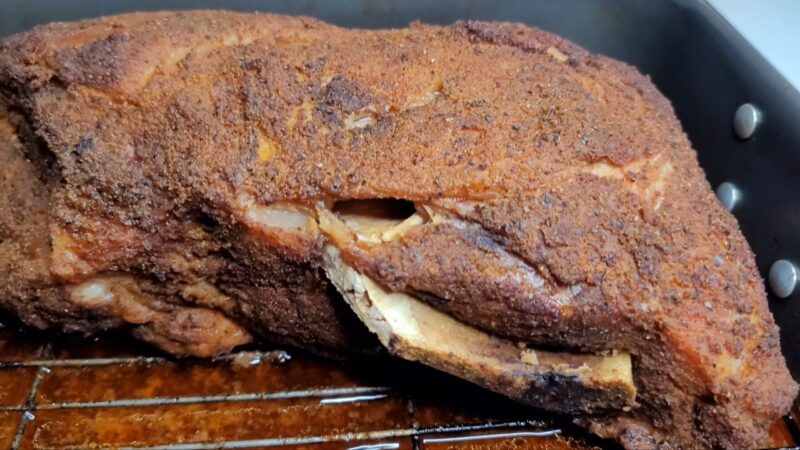Pulled pork is a beloved barbecue dish that requires careful temperature management to achieve the perfect texture and flavor. The optimal temperature for cooking pulled pork is a topic of debate among barbecue enthusiasts. Some recommend cooking the pork to an internal temperature of 190°F, while others prefer 205°F.
Cooking at 190°F allows for slow collagen breakdown, resulting in tender and juicy pork, but it requires patience and careful temperature management. Cooking at 205°F produces a more time-efficient option with juicy and flavorful meat, but there is a risk of overcooking. Ultimately, the choice depends on personal preference and desired outcome.
Key Takeaways:
- The debate over the optimal cooking temperature for pulled pork centers around 190°F versus 205°F.
- Cooking at 190°F allows for slow collagen breakdown, resulting in tender and juicy pork.
- Cooking at 205°F offers a more time-efficient option with juicy and flavorful meat, but there is a risk of overcooking.
- The choice between temperatures ultimately depends on personal preference and desired outcome.
- Temperature management is crucial for achieving the perfect texture and flavor in pulled pork.
The Debate: 190°F vs 205°F
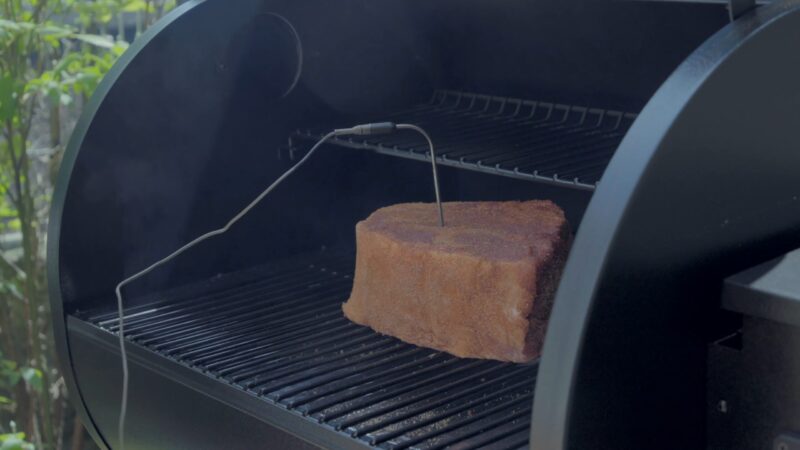
The optimal temperature for cooking pulled pork is a hotly debated topic among barbecue enthusiasts, with conflicting opinions on whether 190°F or 205°F is the right choice. Each temperature option comes with its own advantages and considerations, making the decision a matter of personal preference and desired outcome.
At 190°F, the slow and steady approach to cooking pulled pork allows for a gradual breakdown of collagen, resulting in exceptionally tender and juicy meat. This lower temperature requires patience and careful temperature management, as it can take several hours to achieve the desired result. However, the end product is often worth the wait, with flavors that are deeply infused into the meat.
On the other hand, cooking pulled pork at 205°F offers a more time-efficient option. The higher temperature speeds up the cooking process, reducing the overall cooking time. This is especially useful for those who are short on time but still desire juicy and flavorful meat. However, cooking at a higher temperature comes with the risk of overcooking the pork, which can result in a drier texture and less desirable flavors.
Ultimately, the choice between 190°F and 205°F comes down to personal preference and desired outcome. Some barbecue enthusiasts swear by the slow and tender approach of cooking at 190°F, emphasizing the patience and attention to detail required. Others prefer the efficiency and slightly different flavors achieved at 205°F. Whichever temperature you choose, be sure to use a reliable thermometer and adjust cooking times accordingly to ensure the internal temperature reaches the desired level of doneness.
Cooking at 190°F: Slow and Tender
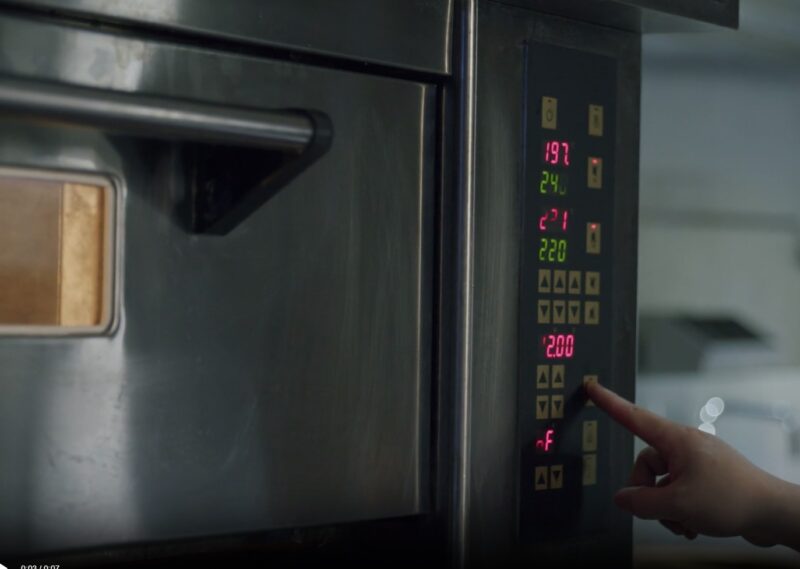
Cooking pulled pork at 190°F offers a slow and steady approach to achieving tender and juicy meat, thanks to the gradual breakdown of collagen. This lower temperature allows the connective tissues in the pork to break down slowly over time, resulting in meat that practically melts in your mouth. Patience is key when using this method, as it can take several hours for the collagen to fully dissolve and the pork to reach the desired level of tenderness.
Careful temperature management is crucial when cooking at 190°F. It’s important to maintain a consistent heat source throughout the cooking process to ensure even cooking and prevent any temperature fluctuations. Using a reliable thermometer is essential for accurately monitoring the internal temperature of the pork, allowing you to adjust the cooking time as necessary.
“Cooking pulled pork at 190°F gives me the best results every time. The meat turns out incredibly tender and juicy, with a rich and smoky flavor that’s hard to beat,” says BBQ enthusiast John Smith.
“I’ve learned that a little patience goes a long way when slow-cooking pork. I make sure to check the temperature regularly and adjust the cooking time as needed to achieve that perfect texture and flavor.”
| Benefits of Cooking at 190°F |
|---|
| Slow breakdown of collagen |
| Tender and juicy pork |
| Rich and smoky flavor |
While cooking pulled pork at 190°F requires time and attention, the end result is well worth the effort. The collagen breakdown and slow cooking process create a sensory experience that will delight any BBQ lover. Whether you’re hosting a backyard gathering or simply treating yourself to a delicious homemade meal, cooking at 190°F offers a foolproof method for achieving the perfect pulled pork.
Cooking at 205°F: Efficient and Flavorful
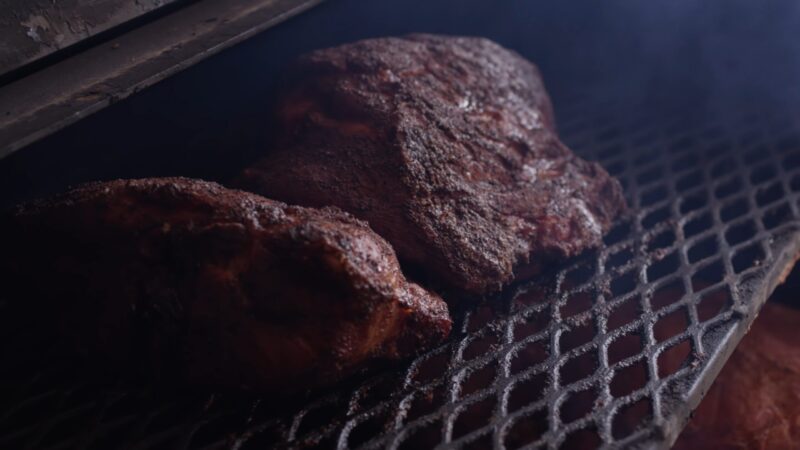
For those seeking a more time-efficient option, cooking pulled pork at 205°F can deliver juicy and flavorful meat, but it requires careful monitoring to avoid overcooking. This higher temperature accelerates the cooking process, reducing the overall cook time and allowing you to enjoy your delicious meal sooner. However, it’s crucial to find the right balance between efficient cooking and preserving the tenderness and moisture of the pork.
The risk of overcooking is one of the main considerations when cooking at 205°F. The higher temperature can cause the meat to dry out if not carefully managed. It’s essential to monitor the internal temperature of the pork regularly and ensure it reaches the desired level of doneness without surpassing it. A reliable meat thermometer is your best friend in achieving perfectly cooked, juicy pulled pork.
Despite the risk, cooking at 205°F can result in a flavorful and moist finished product. The higher temperature promotes more collagen breakdown, leading to tender meat that melts in your mouth. The increased cooking speed also enhances the smoky and caramelized flavors that many barbecue enthusiasts enjoy in their pulled pork. Just remember to stay attentive and make any necessary adjustments to prevent overcooking.
| Temperature | Advantages | Considerations |
|---|---|---|
| 205°F | Juicy and flavorful meat | Risk of overcooking |
In conclusion, cooking pulled pork at 205°F offers a time-efficient option to achieve delicious and flavorful meat. However, it’s important to be mindful of the risk of overcooking and ensure careful temperature monitoring throughout the process. Whether you choose to cook at 190°F or 205°F ultimately depends on personal preference and desired outcome. Experiment with both temperatures to find the perfect balance of tenderness, flavor, and efficiency for your pulled pork masterpiece.
Personal Preference and Desired Outcome
The decision between cooking pulled pork at 190°F or 205°F boils down to personal preference and the desired outcome you envision for your barbecue feast. Both temperatures have their merits and it’s important to consider what you value most in your pulled pork.
If you’re a fan of tender and juicy meat that melts in your mouth, cooking at 190°F might be the right choice for you. This lower temperature allows for a slow breakdown of collagen, resulting in incredibly tender and flavorful pork. The process takes time and patience, but the end result is well worth it. Just make sure to carefully manage the temperature throughout the cooking process to achieve the perfect balance.
On the other hand, if you’re looking for a more time-efficient option that still delivers juicy and flavorful meat, cooking at 205°F might be your preference. The higher temperature speeds up the cooking process, allowing you to enjoy your pulled pork sooner. However, keep in mind that there is a risk of overcooking the meat if you’re not careful. So, if you prefer a quicker cook time and don’t mind sacrificing a bit of tenderness, 205°F could be the right choice for you.
Factors to Consider
- Your taste preferences: Do you prefer tender and melt-in-your-mouth pork, or are you more focused on a quicker cook time?
- Your desired texture: Are you looking for a more fall-apart texture or a firmer bite?
- The occasion: Consider the overall dining experience you want to create. Will you be serving the pulled pork as a centerpiece for a special celebration or simply enjoying it as part of a casual meal?
Ultimately, there is no one-size-fits-all answer when it comes to the optimal cooking temperature for pulled pork. It’s all about what you enjoy and what you want to achieve with your barbecue masterpiece. So, consider your personal preferences and desired outcome, and let your taste buds guide you. Whether you choose to cook at 190°F or 205°F, rest assured that with the right techniques and temperature management, you’ll be able to create a delicious pulled pork that will impress your guests and satisfy your own cravings.
| Temperature | Tenderness | Flavor | Cooking Time |
|---|---|---|---|
| 190°F | Tender and juicy | Intensely flavored | Longer cooking time |
| 205°F | Juicy and flavorful | Rich and balanced | Shorter cooking time |
Achieving the Perfect Pulled Pork
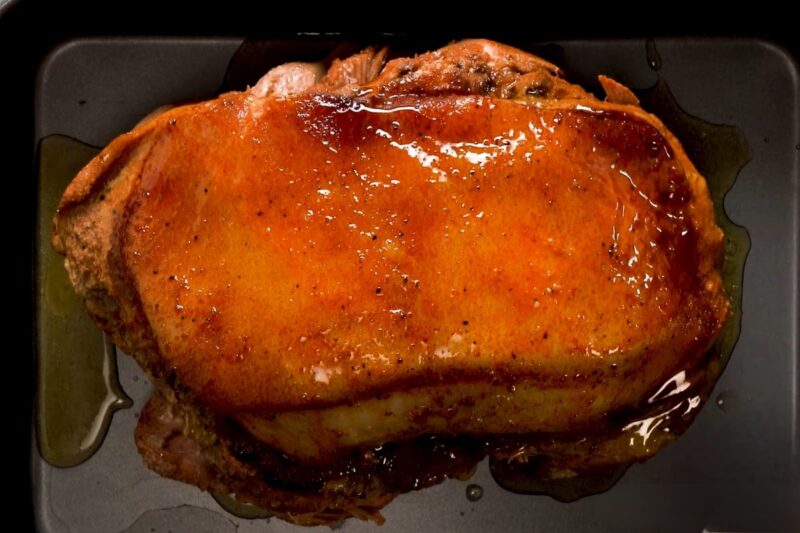
Discovering the perfect temperature for your pulled pork is the key to a mouthwatering feast that will satisfy even the most discerning BBQ-lover’s palette. Whether you prefer your pulled pork slow and tender or efficient and flavorful, temperature plays a crucial role in determining the outcome.
Cooking pulled pork at 190°F offers a slow and patient approach. This lower temperature allows for a gradual breakdown of collagen, resulting in tender and juicy pork that melts in your mouth. However, it requires careful temperature management and a bit of patience. Keeping the heat consistent and adjusting cooking times accordingly is essential when aiming for the perfect texture and flavor.
If time is of the essence, cooking pulled pork at 205°F can be a more efficient option. The higher temperature speeds up the cooking process, reducing the overall cooking time. This method yields juicy and flavorful meat that is sure to delight your taste buds. However, it’s important to be mindful of the risk of overcooking. Keeping a close eye on the internal temperature and monitoring the pork’s progress will help you achieve the ideal balance between tenderness and doneness.
Ultimately, the choice between 190°F and 205°F comes down to personal preference and desired outcome. Some BBQ enthusiasts prefer the slow and tender approach, savoring the process and relishing every bite of their perfectly cooked pulled pork. Others opt for the efficiency and bold flavors that cooking at a higher temperature brings. Whichever route you choose, experimenting with different temperatures and techniques will help you discover the golden temperature that suits your taste and guarantees a mouthwatering pulled pork every time.
Table: Pulled Pork Temperature Guide
| Temperature | Result |
|---|---|
| 190°F | Tender and juicy pulled pork with slow collagen breakdown |
| 205°F | Efficient and flavorful pulled pork with reduced cooking time |
Tips for Temperature Management
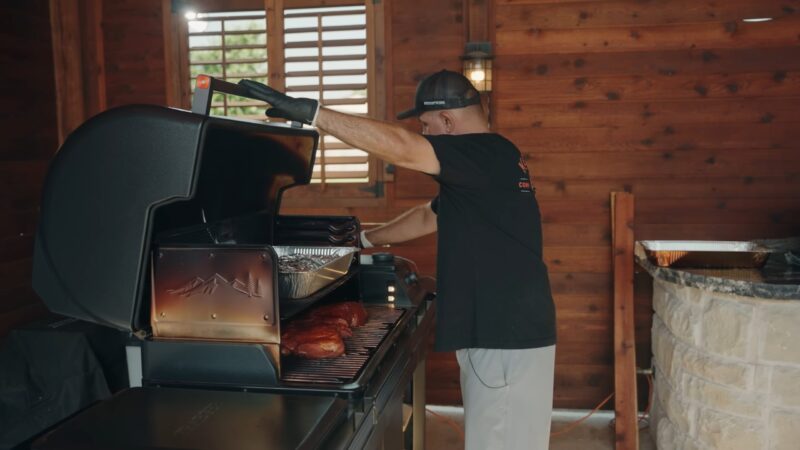
Mastering temperature management is essential for cooking pulled pork to perfection, and these tips will help you navigate the process with confidence.
1. Use a reliable thermometer: Invest in a good-quality meat thermometer to ensure accurate temperature readings. Insert the probe into the thickest part of the pork, away from bones, for the most accurate results.
2. Maintain a consistent heat source: Whether you’re using a smoker, grill, or oven, it’s crucial to maintain a consistent heat source throughout the cooking process. Fluctuations in temperature can affect the tenderness and flavor of the pulled pork.
3. Adjust cooking times: Depending on the temperature chosen, you may need to adjust the cooking times accordingly. Cooking at 190°F will require more time for collagen breakdown, while cooking at 205°F will be more time-efficient. Keep a close eye on the internal temperature and adjust cooking times as needed.
4. Rest the meat: After cooking the pulled pork, allow it to rest for 15-30 minutes before shredding. This resting period allows the juices to redistribute, resulting in a more tender and flavorful final product.
| Tips for Temperature Management |
|---|
| Use a reliable thermometer |
| Maintain a consistent heat source |
| Adjust cooking times |
| Rest the meat |
The Art of Smoking Pulled Pork
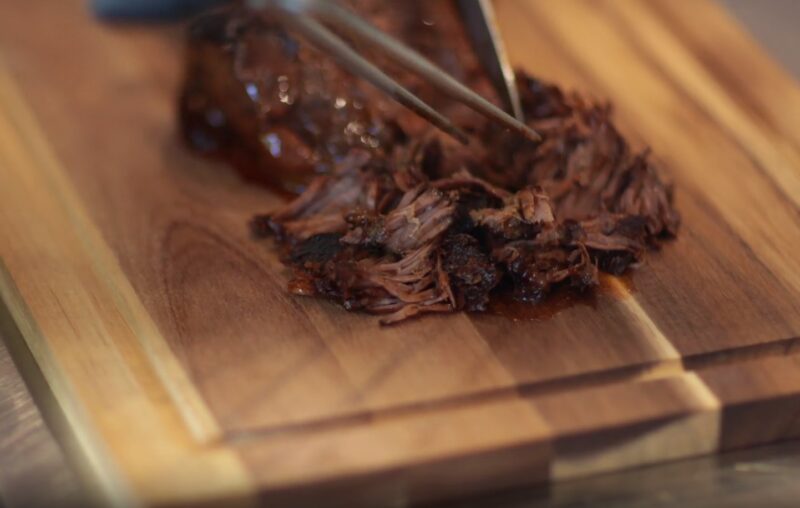
Elevate your pulled pork game by exploring the art of smoking, adding a smoky and irresistible touch to your homemade masterpiece. Smoking pulled pork takes your culinary skills to new heights, infusing the meat with unique flavors that can’t be replicated by other cooking methods. Whether you prefer a traditional barbecue flavor or want to experiment with different wood chips for a more nuanced taste, smoking is the way to go.
When it comes to smoking pulled pork, there are a few key elements to consider. First and foremost, you’ll need a reliable smoker. From kamado grills to offset smokers, you have a range of options to choose from based on your preferences and budget. Ensure that your smoker is capable of maintaining a consistent temperature, as this is crucial for achieving tender and flavorful results.
Next, select the right wood chips or chunks to complement your pulled pork. Popular choices include hickory, apple, cherry, and mesquite, each adding its own distinct flavor profile. Soak the wood chips beforehand to help them smolder and release flavorful smoke during the cooking process. Remember, the type of wood you use can significantly impact the final taste of your smoked pulled pork.
Smoking Tips and Techniques
- Preheat your smoker to the desired temperature before adding the pork. This ensures that the meat cooks evenly and absorbs the smoky flavors from the start.
- Use a dry rub or marinade to enhance the flavor of the pulled pork. Allow the meat to marinate for a few hours or overnight before smoking.
- Monitor the temperature throughout the smoking process, aiming for a range of 225°F to 250°F. This slow and low cooking method allows the collagen in the meat to break down gradually, resulting in tender, juicy pulled pork.
- Consider using a water pan in your smoker to maintain moisture and prevent the meat from drying out during the long cooking time.
- Plan for a longer cooking time when smoking pulled pork, as it typically takes several hours to reach the desired tenderness. Patience is key in achieving the perfect smoked pulled pork.
Once your smoked pulled pork is ready, it’s time to serve up a delicious feast. Whether you’re planning a backyard barbecue or simply craving a comforting meal, this homemade masterpiece will undoubtedly impress. Pair it with your favorite barbecue sauce, serve it on buns as sandwiches, or enjoy it on its own alongside some traditional sides like coleslaw and baked beans.
| Wood Chip | Flavor Profile |
|---|---|
| Hickory | Strong and smoky |
| Apple | Sweet and fruity |
| Cherry | Mild and slightly sweet |
| Mesquite | Bold and earthy |
FAQ
What are the benefits of cooking pulled pork at 205°F?
Cooking pulled pork at 205°F produces a more time-efficient option with juicy and flavorful meat. However, there is a risk of overcooking.
How do I choose the right temperature for cooking pulled pork?
The choice between 190°F and 205°F depends on personal preference and desired outcome. Consider your own taste preferences and cooking goals when deciding which temperature to use.
How do I achieve the perfect pulled pork?
Achieving the perfect pulled pork involves finding the golden temperature that suits your taste. Experiment with different temperatures to create a feast that will please any BBQ-lover’s palette.
What are some tips for temperature management when cooking pulled pork?
To manage temperatures when cooking pulled pork, use a reliable thermometer, maintain a consistent heat source, and adjust cooking times based on the temperature chosen.
Can I smoke pulled pork?
Yes, smoking pulled pork adds an additional flavor dimension. Explore the art of smoking with the right techniques and equipment to create homemade smoked pulled pork.
Final Words
With temperature as your guide, you can unlock the secrets to creating the best-pulled pork that is both easy to make and absolutely delicious. And remember, the art of smoking pulled pork adds another layer of flavor.
If you have the equipment and time, consider experimenting with smoking techniques for a truly homemade smoked pulled pork experience.

